fuel cap CHEVROLET TRACKER 1998 1.G Owners Manual
[x] Cancel search | Manufacturer: CHEVROLET, Model Year: 1998, Model line: TRACKER, Model: CHEVROLET TRACKER 1998 1.GPages: 386, PDF Size: 21.17 MB
Page 123 of 386

Downloaded from www.Manualslib.com manuals search engine If the Light Is Flashing
The following may prevent more serious damage to
your vehicle:
Reducing vehicle speed.
0 Avoiding hard accelerations.
Avoiding steep uphill grades.
If the Light Is On Steady
If you are towing a trailer, reduce the amount of
cargo being hauled as soon as it is possible.
If the light stops flashing and remains on steady, see
“If
the Light Is On Steady’’ following.
If the light continues to flash, when it is safe to do so,
stop the vehicle. Find a safe place to park your vehicle.
Turn the key off, wait at least 10 seconds and restart the
engine. If the light remains on steady, see “If the Light
Is On Steady’’ following. If the light is still flashing,
follow the previous steps, and drive the vehicle to your
dealer or qualified service center for service.
You may be able to correct the emission system
malfunction by considering the following:
Did you recently put fuel into your vehicle?
If so, reinstall the fuel cap, making sure to fully install
the cap. The diagnostic system can determine if the fuel
cap has been left
off or improperly installed. A loose or
missing fuel cap will allow fuel to evaporate into the
atmosphere.
A few driving trips with the cap properly
installed should
turn the light off.
Did you just drive through a deep puddle of water?
If so, your electrical system may be wet. The condition
will usually be corrected when the electrical system
dries out. A few driving trips should
turn the light off.
Are you low on fuel?
As your engine starts to run out of fuel, your engine may
not run as efficiently as designed since small amounts of
air are sucked into the fuel line causing a misfire. The
system can detect
this. Adding fuel should correct this
condition. Make sure to install the fuel cap properly. It
will take a few driving trips to turn the light
off.
j
2-64
I
~ i
I
Page 126 of 386
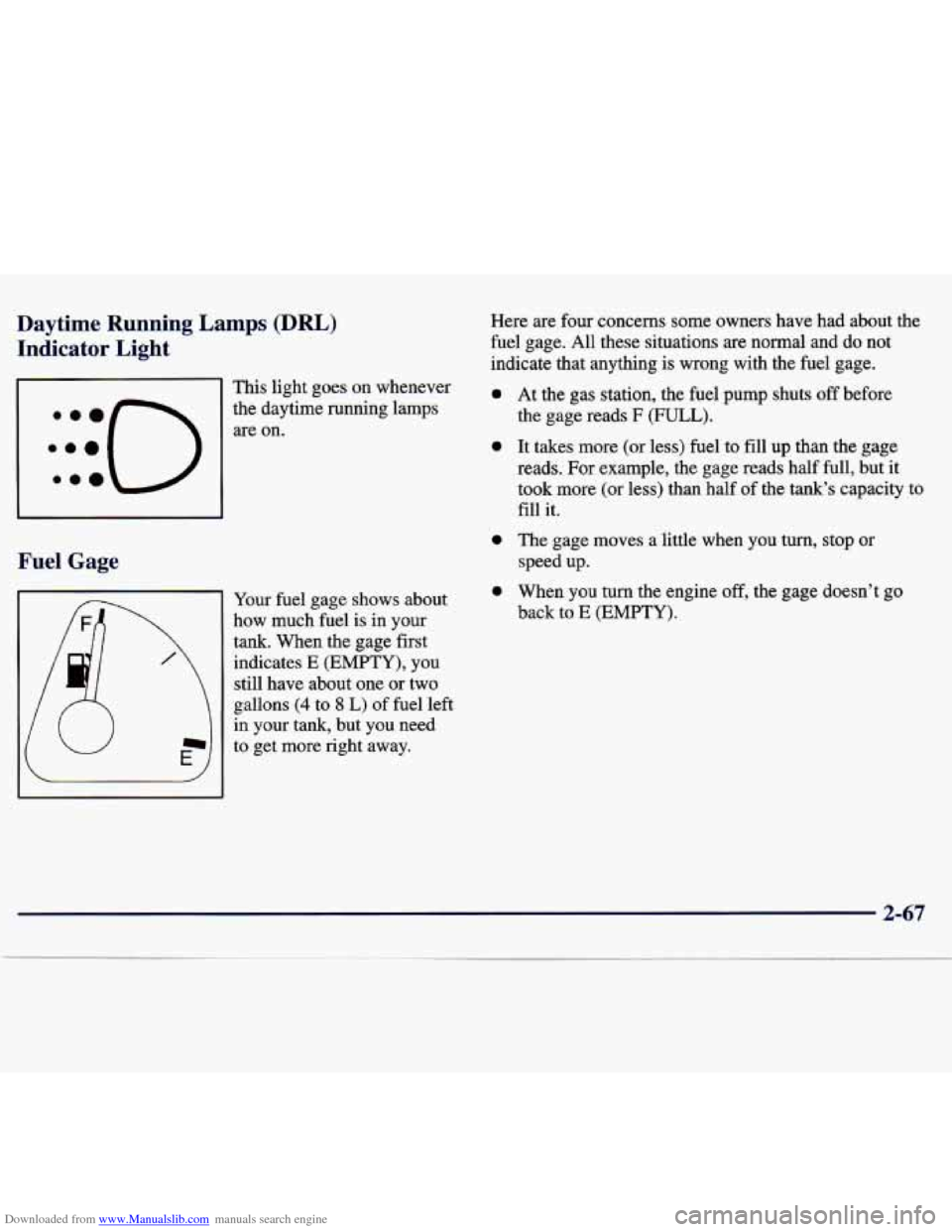
Downloaded from www.Manualslib.com manuals search engine Daytime Running Lamps (DRL)
Indicator Light
Here are four concerns some owners have had about the
fuel gage. All these situations
are normal and do not
indicate that anything is wrong with the fuel gage.
This light goes
on whenever
the daytime running lamps
are on. 0
0
Fuel Gage
Your fuel gage shows about
how much fuel is in your
tank. When the gage first
indicates
E (EMPTY), you
still have about one or two
gallons
(4 to 8 L) of fuel left
in your tank, but you need
to get more right away.
0
0
At the gas station, the fuel pump shuts off before
the gage reads
F (FULL).
It takes more (or less) fuel to fill up than the gage
reads. For example, the gage reads half full, but it
took more (or less) than half of the tank’s capacity to
fill it.
The gage moves
a little when you turn, stop or
speed up.
When you turn the engine off, the gage doesn’t go
back to
E (EMPTY).
2-67
Page 191 of 386
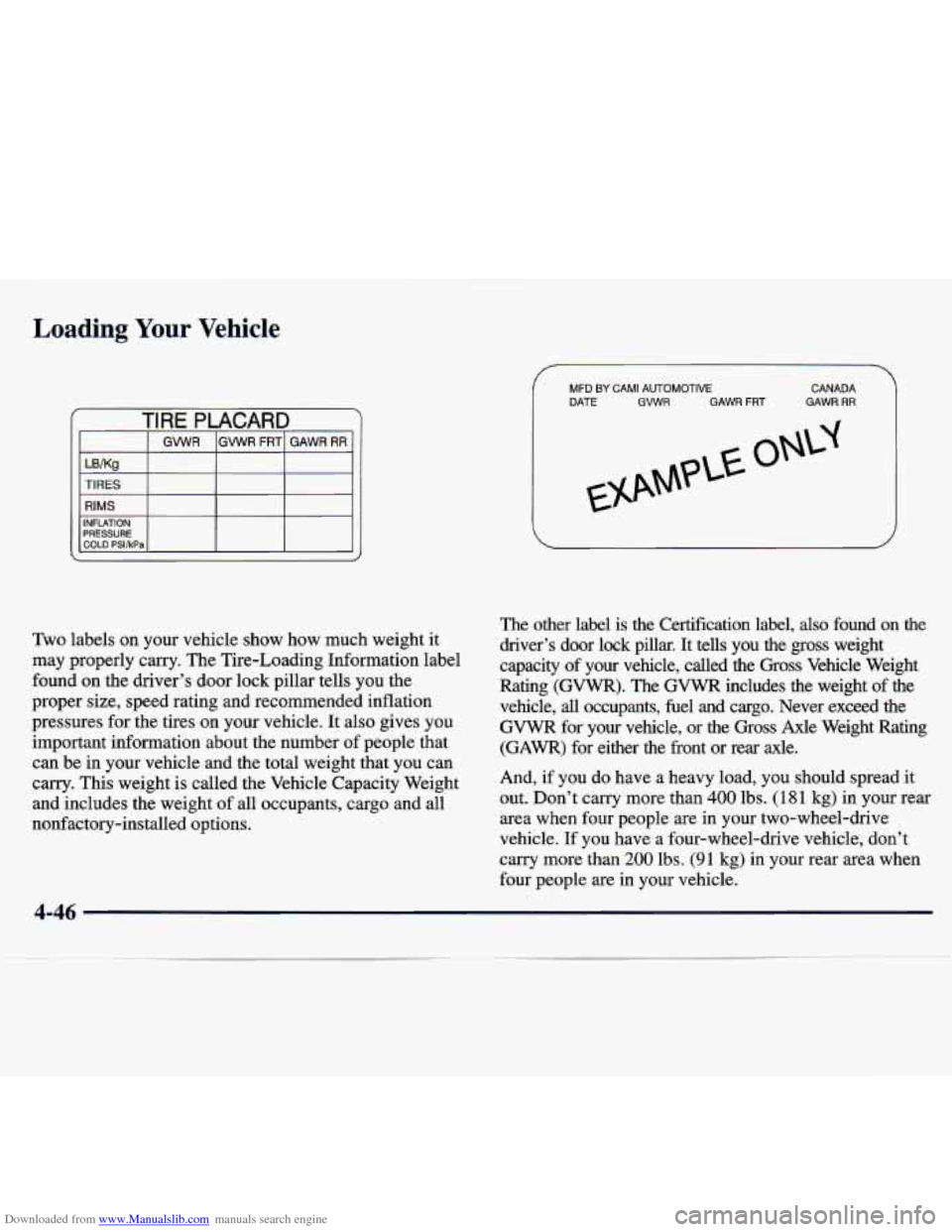
Downloaded from www.Manualslib.com manuals search engine Loading Your Vehicle
TIRES
RIMS
MFD BY CAM1 AUTOMOTIVE
I DATE CANADA
GVWR GAWR FRT GAWR RR
Two labels on your vehicle show how much weight it
may properly carry. The Tire-Loading Information label
found on the driver's door lock pillar tells you the
proper size, speed rating and recommended inflation
pressures for the tires on your vehicle. It also gives you
important information about the number of people that
can be in your vehicle and the total weight that you can carry. This weight is called the Vehicle Capacity Weight
and includes the weight
of all occupants, cargo and all
nonfactory-installed options. The other label is the Certification label,
also found on the
driver's door lock pillar. It tells you the
gross weight
capacity of your vehicle, called the
Gross Vehicle Weight
Rating (GVWR). The GVWR includes the weight of the vehicle, all occupants,
fuel and cargo. Never exceed the
GVWR for your vehicle, or the Gross Axle Weight Rating
(GAWR) for either the front or rear axle.
And, if
you do have a heavy load, you should spread it
out. Don't carry more than
400 lbs. (1 8 1 kg) in your rear
area when four people are in your two-wheel-drive
vehicle.
If you have a four-wheel-drive vehicle, don't
carry more than
200 lbs. (9 1 kg) in your rear area when
four people are in your vehicle.
Page 193 of 386
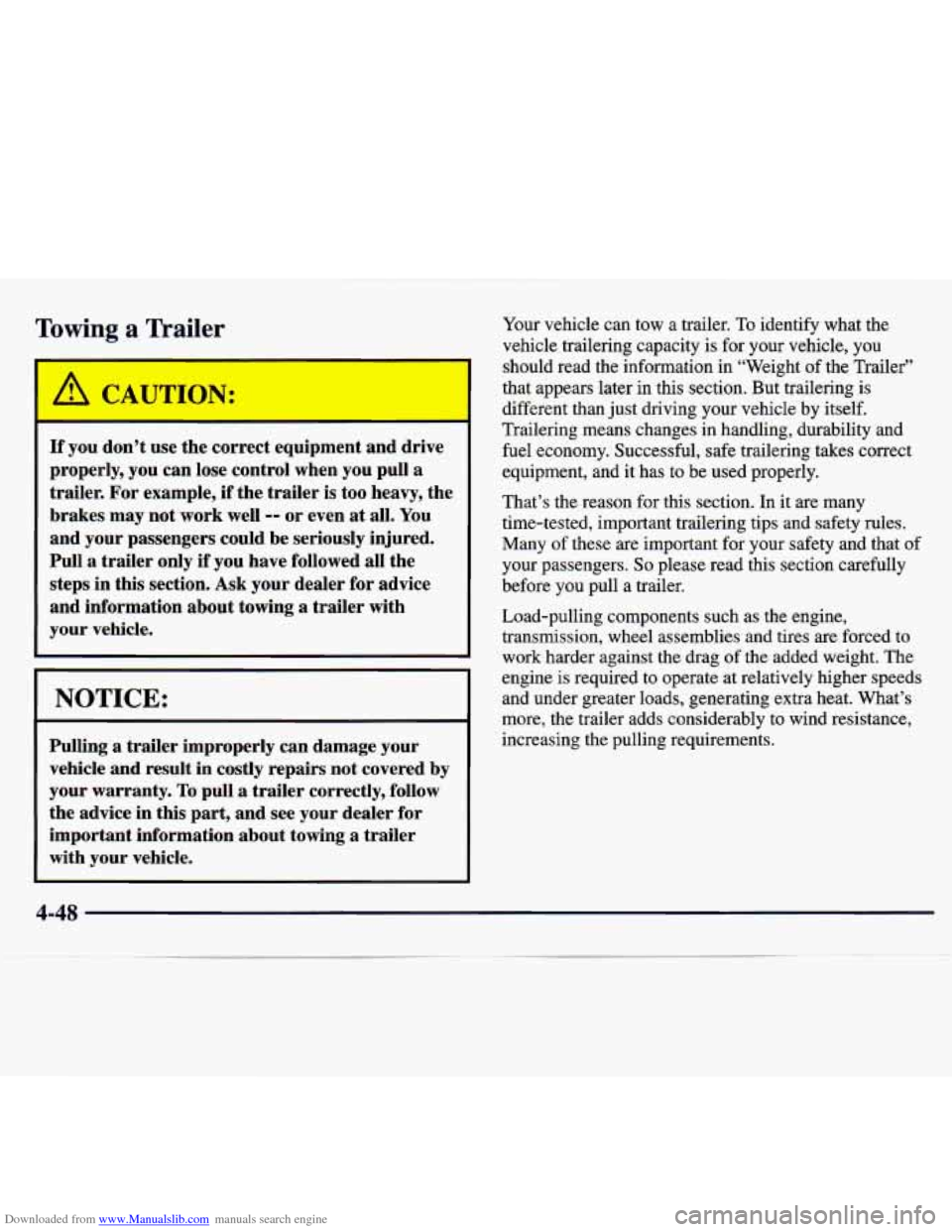
Downloaded from www.Manualslib.com manuals search engine Towing a Trailer
If you don’t use the correct equipment and drive
properly, you can lose control when you pull a
trailer. For example,
if the trailer is too heavy, the
brakes may not work well
-- or even at all. You
and your passengers could be seriously injured.
Pull a trailer only
if you have followed all the
steps in this section. Ask your dealer for advice
and
information about towing a trailer with
your vehicle.
NOTICE:
Pulling a trailer improperly can damage your
vehicle and result in costly repairs not covered
by
your warranty. To pull a trailer correctly, follow
the advice in this part, and see your dealer for
important information about towing a trailer
with your vehicle. Your
vehicle can tow a trailer. To identify what the
vehicle trailering capacity is for your vehicle, you
should read the information in “Weight of the Trailer’,
that appears later in this section. But trailering is
different than just driving your vehicle by itself.
Trailering means changes in handling, durability and
fuel economy. Successful, safe trailering takes correct
equipment, and it has to be used properly.
That’s the reason for this section. In it
are many
time-tested, important trailering tips and safety rules.
Many of these are important for your safety and that of
your passengers.
So please read this section carefully
before you pull a trailer.
Load-pulling components sucn as me engine,
transmission, wheel assemblies and tires
are forced to
work harder against the drag
of the added weight. The
engine
is required to operate at relatively higher speeds
and under greater loads, generating extra heat. What’s
more, the trailer adds considerably to wind resistance,
increasing the pulling requirements.
4-48
Page 238 of 386
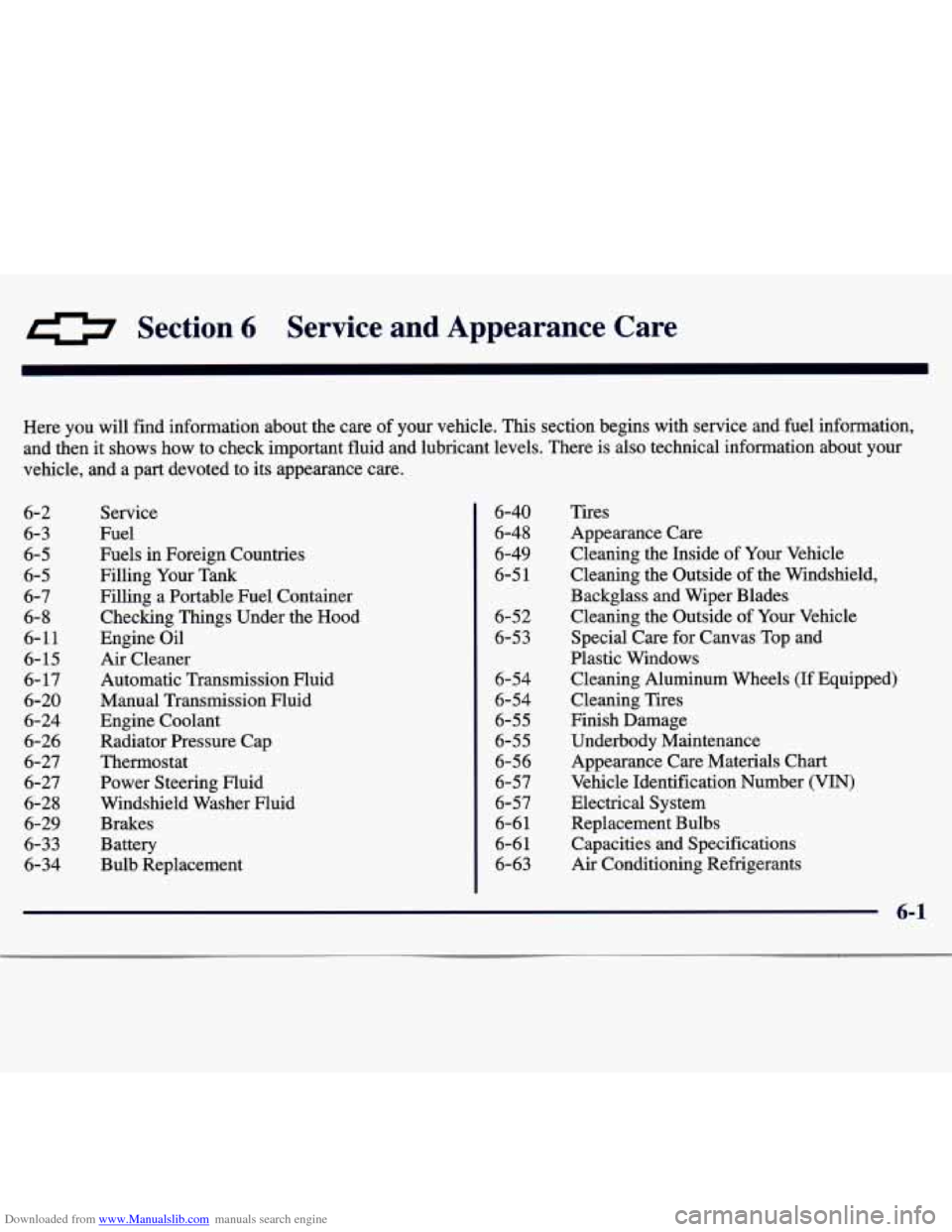
Downloaded from www.Manualslib.com manuals search engine 0 Section 6 Service and Appearance Care
Here you will find information about the care of your vehicle. This section begins with service and fuel information,
and then it shows how to check important fluid and lubricant levels. There is also technical i\
nformation about your
vehicle, and a part devoted to its appearance care.
6-2
6-3
6-5
6-5
6-7
6- 8 6-11
6-15
6-17
6-20
6-24
6-26
6-27
6-27
6-28
6-29
6-33
6-34 Service
Fuel
Fuels in Foreign Countries
Filling Your Tank
Filling a Portable Fuel Container
Checking Things Under the Hood
Engine Oil
Air Cleaner
Automatic Transmission Fluid
Manual Transmission Fluid
Engine Coolant
Radiator Pressure Cap
Thermostat
Power Steering Fluid
Windshield Washer Fluid Brakes
Battery
Bulb Replacement 6-40
6-48
6-49
6-5
1
6-52
6-53
6-54
6-54
6-55
6-55
6-56 6-57
6-57
6-61
6-6
1
6-63 Tires
Appearance Care Cleaning the Inside of Your Vehicle
Cleaning the Outside
of the Windshield,
Backglass and Wiper Blades
Cleaning the Outside of Your Vehicle
Special Care for Canvas Top and
Plastic Windows
Cleaning Aluminum Wheels
(If Equipped)
Cleaning Tires
Finish Damage
Underbody Maintenance
Appearance Care Materials Chart
Vehicle Identification Number (VIN)
Electrical System Replacement Bulbs
Capacities and Specifications
Air Conditioning Refrigerants
6-1
Page 243 of 386
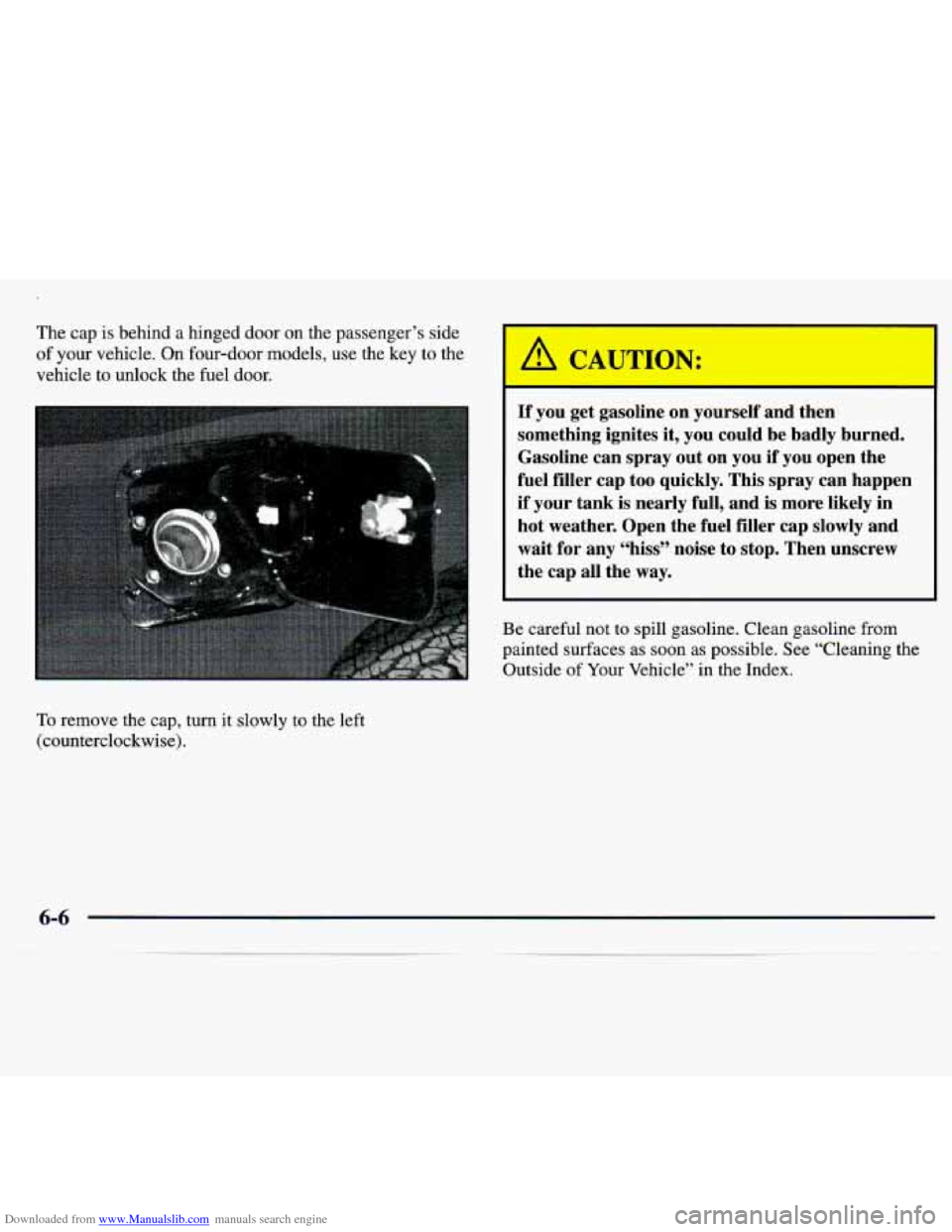
Downloaded from www.Manualslib.com manuals search engine The cap is behind a hinged door on the passenger’s side
of your vehicle. On four-door models,
use the key to the
vehicle to unlock
the fuel door.
To remove the cap, turn it slowly to the left
(counterclockwise).
I a CAUTION:
If you get gasoline on yourself and then
something ignites it, you could be badly burned.
Gasoline can spray out on you
if you open the
fuel filler cap too quickly. This spray can happen
if your tank is nearly full, and is more likely in
hot weather. Open the fuel filler cap slowly and
wait for any “hiss” noise to stop. Then unscrew
the cap all the way.
Be careful not to spill gasoline. Clean gasoline
from
painted surfaces as soon as possible. See “Cleaning the
Outside
of Your Vehicle” in the Index.
6-6
Page 244 of 386
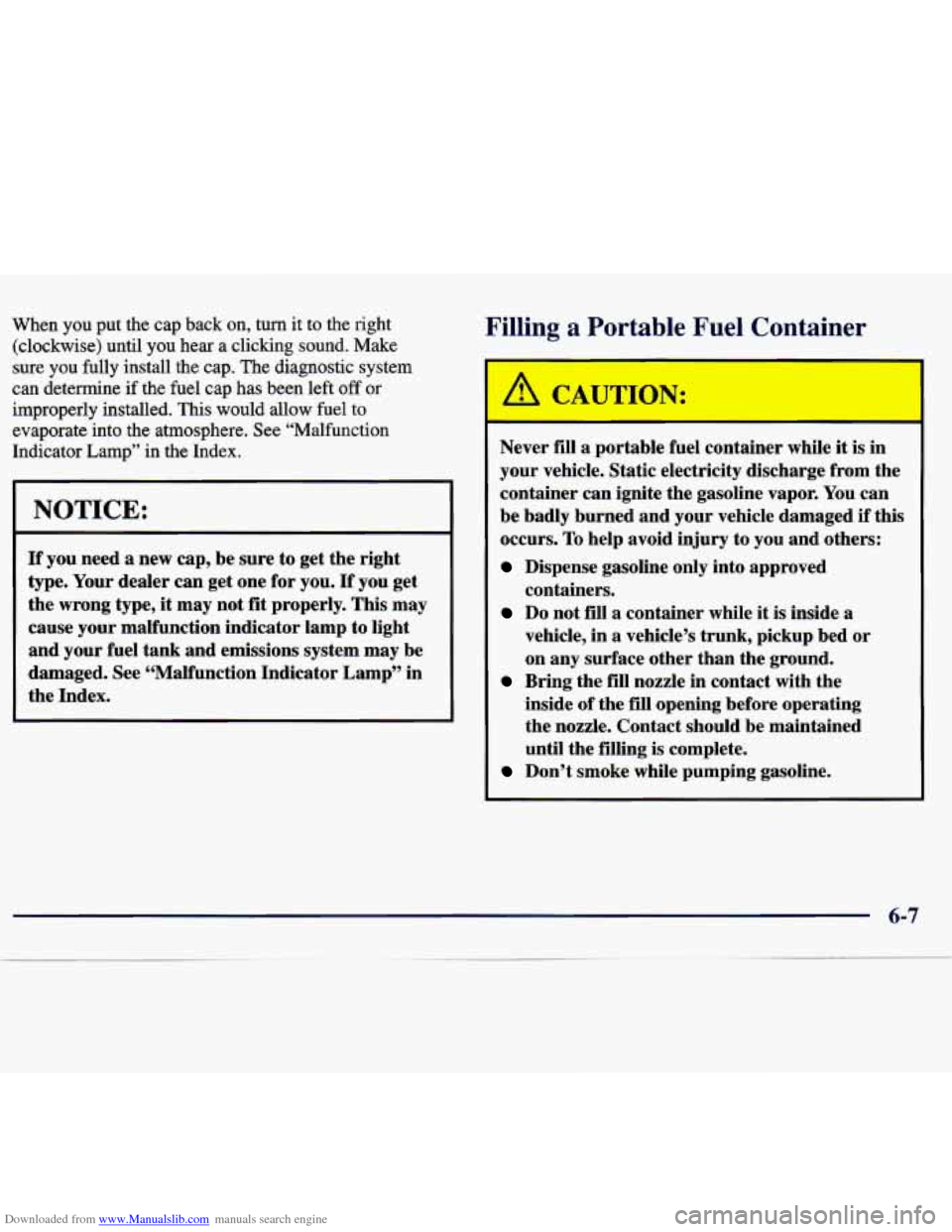
Downloaded from www.Manualslib.com manuals search engine When you put the cap back on, turn it to the right
(clockwise) until you hear a clicking sound. Make
sure you fully install the cap.
The diagnostic system
can determine
if the fuel cap has been left off or
improperly installed. This would allow fuel to
evaporate into the atmosphere. See “Malfunction
Indicator Lamp” in the Index.
NOTICE:
If you need a new cap, be sure to get the right
type. Your dealer can get one for you. If you get
the wrong type,
it may not fit properly. This may
cause your malfunction indicator lamp to light
and your fuel tank and emissions system may be
damaged. See “Malfunction Indicator Lamp’’ in
the Index.
Filling a Portable Fuel Container
A CAU ,ION:
Never fill a portable fuel container while it is in
your vehicle. Static electricity discharge from the
container can ignite the gasoline vapor.
You can
be badly burned and your vehicle damaged
if this
occurs. To help avoid injury to you and others:
Dispense gasoline only into approved
containers.
Do not fill a container while it is inside a
vehicle, in
a vehicle’s trunk, pickup bed or
on any surface other than the ground.
inside of the fill opening before operating
the nozzle. Contact should be maintained
until the filling is complete.
Bring the fill nozzle in contact with the
Don’t smoke while pumping gasoline.
Page 278 of 386

Downloaded from www.Manualslib.com manuals search engine Inflation -- Tire Pressure
The Tire-Loading Information label, which is on the
driver’s door lock pillar, shows the correct inflation
pressures for your tires when they’re cold. “Cold”
means your vehicle has been sitting for at least three
hours or driven no more than
1 mile ( 1.6 km).
NOTICE:
Don’t let anyone tell you that underinflation or
overinflation
is all right. It’s not. If your tires
don’t have enough
air (underinflation), you can
get the following:
Too much flexing
Too much heat
Tire overloading
Bad wear
Bad handling
0 Bad fuel economy.
NOTICE: (Continued) NOTICE: (Continued)
If your tires have too much air
(overinflation),
you can get the following:
Unusual wear
Bad handling
0 Rough ride
Needless damage from road hazards.
When to Check Check your tires once
a month or more. Also, check
the tire pressure
of the spare tire.
How to Check
Use
a good quality pocket-type gage to check tire
pressure.
You can’t tell if your tires are properly inflated
simply by looking at them. Radial tires may look
properly inflated even when they’re underinflated.
Be sure to put the valve caps back on the valve stems. They help prevent leaks by keeping out dirt
and moisture.
Page 298 of 386
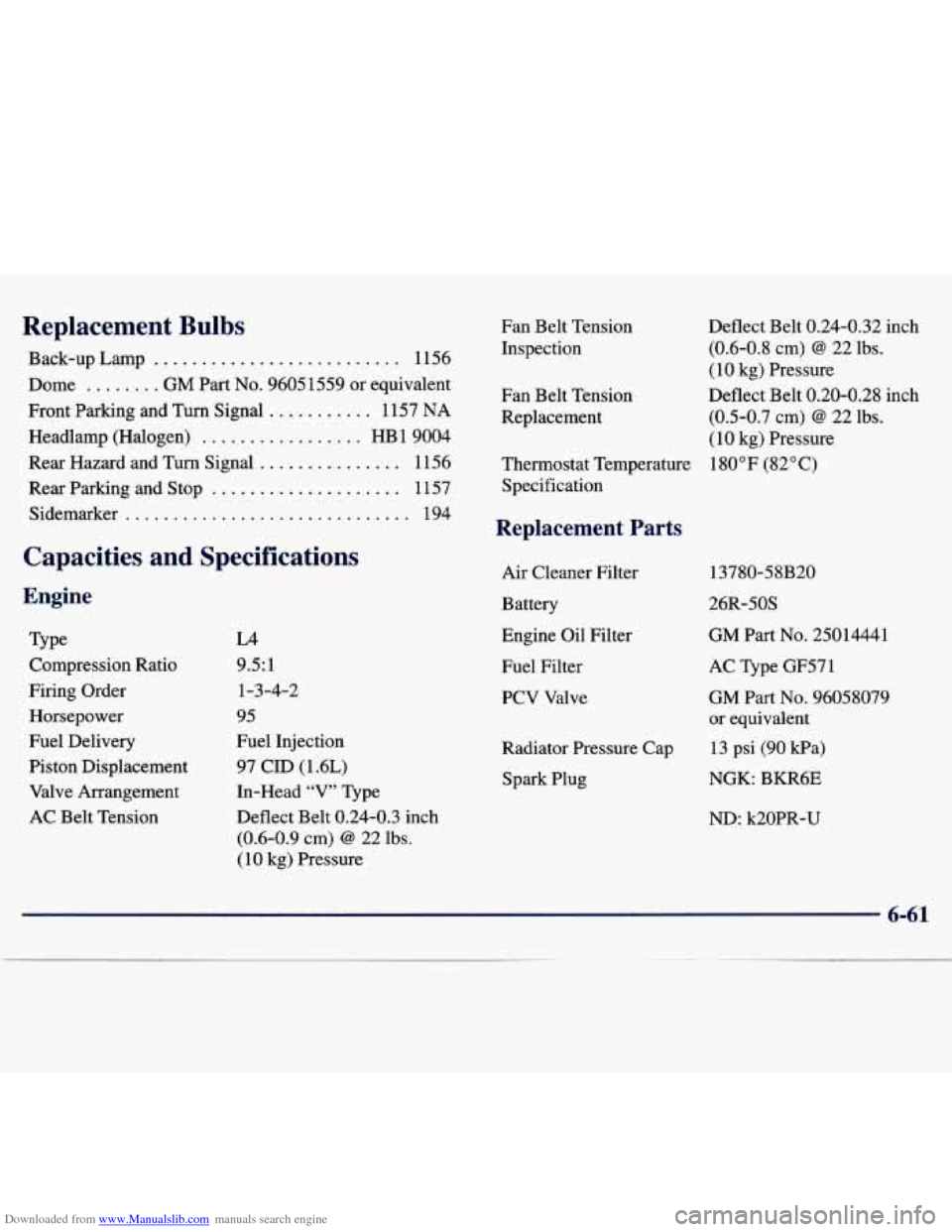
Downloaded from www.Manualslib.com manuals search engine Replacement Bulbs
Back-up Lamp .......................... 1156
Dome
........ GM Part No. 9605 1559 or equivalent
Front Parking and Turn Signal
........... 1157 NA
Headlamp (Halogen)
................. HB19004
Rear Hazard and Turn Signal
............... 1156
Rear Parking and Stop
.................... 1157
Sidemarker
.............................. 194
Capacities and Specifications
Engine
Type Compression Ratio
Firing Order Horsepower
Fuel Delivery
Piston Displacement
Valve Arrangement
AC Belt Tension
LJ4
9.5: 1
1-3-4-2
95
Fuel Injection
97 CID (1.6L)
In-Head
“V” Type
Deflect Belt 0.24-0.3 inch
(0.6-0.9 cm)
@ 22 lbs.
( 10 kg) Pressure Fan Belt Tension Deflect Belt 0.24-0.32 inch
Inspection (0.6-0.8 cm)
@ 22 lbs.
Fan Belt Tension Deflect Belt 0.20-0.28 inch
Replacement
(0.5-0.7 cm) @ 22 lbs.
Thermostat Temperature 1 80°F (82
O C)
Specification (10
kg) Pressure
(10 kg) Pressure
Replacement Parts
Air Cleaner Filter
Battery
Engine Oil Filter
Fuel Filter
PCV Valve
Radiator Pressure
Cap
Spark Plug 13780-58B20
26R-50s
GM Part
No. 25014441
AC Type GF571
GM Part
No. 96058079
or equivalent
13 psi (90 Wa)
NGK: BKR6E
ND: k2OPR-U
6-61
Page 299 of 386
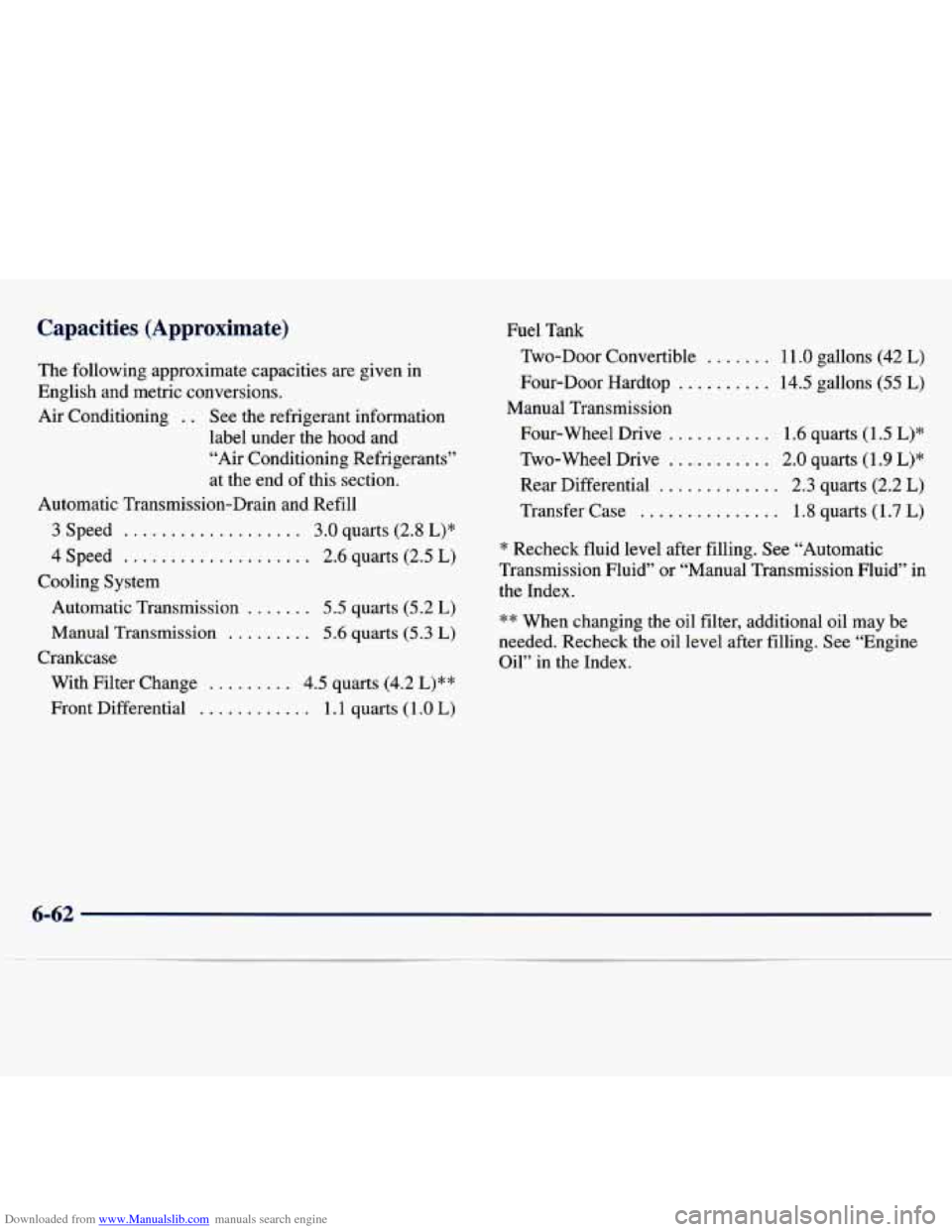
Downloaded from www.Manualslib.com manuals search engine Capacities (Approximate)
The following approximate capacities are given in
English and metric conversions.
Air Conditioning
. . See the refrigerant information
label under the hood and
“Air Conditioning Refrigerants”
at the end of this section.
Automatic Transmission-Drain and Refill
3 Speed ................... 3.0 quarts (2.8 L)*
4 Speed .................... 2.6 quarts (2.5 L)
Automatic Transmission ....... 5.5 quarts (5.2 L)
Manual Transmission ......... 5.6 quarts (5.3 L)
Cooling System
Crankcase
With Filter Change
......... 4.5 quarts (4.2 L)**
Front Differential ............ 1.1 quarts ( 1 .O L)
Fuel Tank
Two-Door Convertible
....... 11 .O gallons (42 L)
Four-Door Hardtop .......... 14.5 gallons (55 L)
Manual Transmission Four-wheel Drive
........... 1.6 quarts (1.5 L)*
Two-Wheel Drive ........... 2.0 quarts (1.9 L)*
Rear Differential ............. 2.3 quarts (2.2 L)
Transfer Case ............... 1.8 quarts (1.7 L)
* Recheck fluid level after filling. See “Automatic
Transmission Fluid” or “Manual Transmission Fluid” in
the Index.
** When changing the oil filter, additional oil may be
needed. Recheck the oil level after filling. See “Engine
Oil” in the Index.
6-62